Page D
(The Study of Threes)
http://threesology.org
This page is a companion to the following links:
- Evolutionary 3s page A
- Evolutionary 3s page B
- Evolutionary 3s page C
- Evolutionary 3s page D
- Evolutionary 3s page F
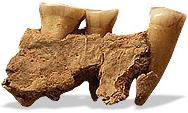
Three-toothed Kent's Cavern jaw bone piece was initially thought to be about 31,000 years old, but re-dating shows it is actually between 37,000 and 40,000 years old. However, the early date provokes the question of whether it is actually from a Neanderthal instead of a modern human. The fragment of maxilla (upper jaw) containing three teeth was unearthed in Kent's Cavern, Torquay, in 1927 during an excavation by the Torquay Natural History Society.
http://news.bbc.co.uk/2/hi/science/nature/4482679.stm
Three fossilised skulls unearthed in Ethiopia are said by scientists to be among the most important discoveries ever made in the search for the origin of humans. (June 2003)
The crania of two adults and a child, all dated to be around 160,000 years old, were pulled out of sediments near a village called Herto in the Afar region in the east of the country. They are described as the oldest known fossils of modern humans, or Homo sapiens.
These specimens are said to be critical because they not only bridge the gap between the earlier more archaic forms in Africa and the fully modern humans that we see 100,000 years ago, but they also support the Out Of Africa Hypothesis for the Origin of modern humans. The specimens are said to fit neatly with the genetic studies that have suggested this particular time period and part of Africa for the emergence of humanity.
The skulls are not an exact match to those of people living today; they are slightly larger, longer and have more pronounced brow ridges. These minor but important differences have prompted the US/Ethiopian research team to assign the skulls to a new subspecies of humans called Homo sapiens idaltu (idaltu means "elder" in the local Afar language).
|
160,000 to 154,000 years old. 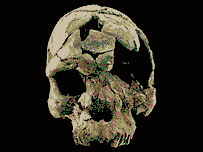 Image ©: David L. Brill |
Did he look like this? 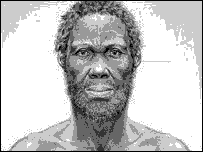 Image ©: J. Matternes |
http://news.bbc.co.uk/2/hi/science/nature/2978800.stm
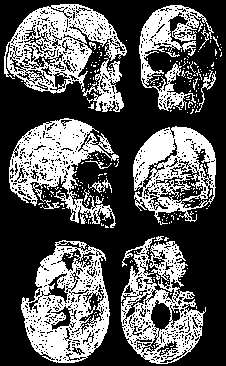
The image to the right is another visual collection of the herto-man skull seen from different vantage points. While we could argue that this particular arrangement is due to a often used rule-of-thumb adhered to in the newspaper printing industry, it is of value in a "threes" context to point out that it can be viewed as a 3 rows of 2 or 2 rows of three, though the skulls could also be laid out in a 1 row of 6 or 6 rows of 1 type of configuration. The way it is presented here is similar to the braille configuration of dots used by blind people to read. While they use a tactile form of perception, sighted persons use a visual form of the same pattern...at least in this instance. However, in thinking about alternative styles of arrangement in a printing context, it is unlikely alternatives such as the 1 row of 6, 6 rows of 1, or variations other than the 3 X 2 (2 X 3) would be used due to constraints of space imposed on journalists in writing articles.
Image source: Salt Lake Tribune-
http://www.sltrib.com/2003/Jun/06122003/thursday/65298.asp
3 frequently discussed fossil bone
structures: Skull~ Pelvis~ Femur
***Are modern women and men
separate but connected species that were each derived from three separate but
connected predecessors?
"Three"-related phenomena examples found in literature on Human origins:
- 3 spears found
- 3 tools found
- "about" 300,000; 3,000,000; 3,000,000,000 years ago
- 3 investigators
- 3 sites
- 3 tests performed
- 3 years; 3 weeks
- 3rd attempt
- 3rd or 3 skulls
- 3 fragments uncovered
- three likely factors remain
- etc...
Yes, I am aware there are other enumerated patterns to be found.
| 3-base coding in DNA is repeated in a manner that is reminiscent of that found in the "reduplications" of infant babbling sequences... prior to the onset of (three) more complex (but repeated) Word ~ Sentence ~ Paragraph arrangements... Will these "babbled" sequences of DNA evolve into simple (singular) words just as the babbling utterances of infants evolve into singular words? Or does DNA already speak in words, sentences and paragraphs that we are as yet unable to decipher because investigative scientists harbor a mind-set of unraveling "mysteries" of life that they, in a manner of speaking, can not see the forest because they are standing too close to the trees? |
For information on infant babbling:
http://www.threesology.org/language-3s-1.php
Until the age of 3 months, human infants have the same-shaped airway as non-human mammals and can breathe and drink at the same time.
Signing apes achieve vocabularies of three year olds:
http://www.cc.gatech.edu/~jimmyd/summaries/miles1994.html
3 diseases (commonly used as examples in discussions about human evolution) which greatly affect the following 3 groups that have developed 3 separate genetic responses:
| Population affected | Disease | Evolution's genetic response |
| African Blacks | Malaria | Sickle-cell gene |
| Ashkenazi Jews | Tuberculosis | Tay-Sachs gene |
| Northern Europeans | Bacterial diarrheas | Cystic Fibrosis gene |
3 qualities of unsickled cells: round ~ smooth ~ flexible
3 recessive disorders have attained unusually high incidences in the Ashkenazi Jewish population of Eastern Europe:
- Tay-Sachs
- Gaucher's
- Niemann - Pick diseases
Three types of point mutations can result from Factor XI (plasma thromboplastin antecedent) deficiency [a bleeding disorder] in Ashkenazi Jews:
- Type I
- Type II
- Type III
by Marilynn Seman
http://www-personal.umd.umich.edu/~jcthomas/JCTHOMAS/1997%20Case%20Studies/M.%20Seman.html
3 considerations of why anatomically modern humans survived amongst other hominid species that did not:
Anatomically modern humans participated in calculated acts of genocide (like gangs, corporations and governments.)
Anatomically modern humans simply out reproduced them into extinction.
The other hominids died due to:
- Disease-
Their hominid form was an expression of how a genetic deformity can spread in an isolated group, but nonetheless extinguish the human host over a period of time.
The Modern human form is a carrier of 1 or more diseases (similar to native Americans being killed off by diseases brought by early European settlers.)
Modern humans were more resistant to a disease that arose due to population increase, but other hominid groups had little or no resistance to the appearance of such a disease.
- Injury- In-group fighting, out-numbered, "out-gunned" by other groups.
- Isolation- Poor exercise of mobility to acquire and maintain a healthy diet.
3 interpretations of Homo erectus fossils:
- It is a single species.
- It is two species, only one of which evolved into modern humans.
- It is not a separate species, but belongs to the diverse group of Homo sapiens that split with Homo habilis.
3 theories concerning human development:
- Theories of Evolution.
- Theories of Creationism.
- Theories of which claim to be totally different than Evolution and Creationism or claim to fuse useful ideas from both (such as the idea of Intelligent Design.)
For one example of an idea being offered as a distinctly different view by its author:
http://www.leaderu.com/real/ri9602/dembski.html
3 species of contemporary domesticated animals greatly affected by Hoof & Mouth disease: Cattle~ Pigs~ Sheep
Note: The word "Domestication" refers to a qualitative degree of "Evolution" in the sense that pre-domesticated species (which include humans), are less evolved. The word "Evolution" can be used quite broadly depending on its application to social issues, biology, religion, etc... and whether it is defined in the long term Darwinian sense, or more loosely with such labels as adaptation, change, alteration, etc..., applied to circumstances involving relatively short periods of time such as "adapting" to one's new work environment, "changing" one's clothes, or "altering" one's opinion. Even though it might sound silly to hear someone say "my eating habits have evolved since breakfast," or that "my sleeping position evolves throughout the night," or "my car has evolved into a 'killer machine' with its new engine," such uses of the word "evolution" would be interpreted by many as merely humorous uses of language without need of scholarly debate.
Three different color morphs (a "morph" is a morphologically distinct subset of a species) of the side-blotched lizard (Uta stansburiana):
The orange, yellow, and blue color morphs differ not only in their throat color, but also in their behavior.
Orange males are very aggressive and mate with lots of females by taking over the territories of other males that the scientist Barry Sinervo calls "usurpers."
Yellow males are "sneakers" who don't defend territories but mimic females and sneak behind the backs of territorial males to cuckold them.
Blue males are mate guarders, keeping a close eye on their mates; they recognize and chase off yellow sneakers, but lose out in confrontations with orange usurpers.
In previous papers, Sinervo has described these strategies as a kind of "rock-paper-scissors" game, where orange defeats blue, blue defeats yellow, and yellow defeats orange. The result is an evolutionarily stable situation in which no single color morph can dominate the population.
http://www.sciencedaily.com/releases/2003/06/030620081012.htm
|
(Neolithics did everything in threes) According to Ted Fawcett, a former National Trust official, the Ring of Brodgar stone circle (Scotland) could have looked totally different when it was originally constructed. He presented the results of his radical research to Ritual Landscapes seminar, organised by ICOMOS-UK, in a talk entitled "Dowsing in the Ring of Brodgar". According to Mr Fawcett, the Ring of Brodgar was originally made up of 900 stones and what remains is just a tiny fraction of the original Neolithic development. He believes the stone circle would have been very much more impressive and imposing to look at when it was still being used for Neolithic ceremonies, thousands of years ago. "At Brodgar, you'll now see 23 stones standing upright, with another lot of crumpled bases which adds up to about 36. But if I'm right, there were something like 900 to start with, which makes it a very different sort of monument, because one of the things one needs to realise about the Neolithics is that they did everything in threes. Where you see one stone now, there were three. So the fraction of a ring that we see would be three stones deep, going in towards the centre and then, out beyond the ditch, there would be another ring and 15 paces from that, another ring. So you get three enormous rings of stones." Said Mr Fawcett. He also added: "They would be entered from north, south, east and west and an avenue of smaller stones leads from those entrance points to the centres. Those stones were smaller and in the very centre there would be a hardened area of about 21 paces across, I think. At the very centre of that hardened area there would be a single upright stone. But the almost unique thing about the Ring of Brodgar is that although it is divided into quadrants by the approach avenues, in each of those quadrants, there was a subsidiary hardened centre with a stone in the middle of it." Mr Fawcett substantiated his hypothesis during successive visits to Orkney and accepts that the findings are open to interpretation. He explained: "The interpreter is the human being and you can always make incorrect interpretations." Unfortunately however, the geophysics scans of the entire Brodgar peninsula last year have revealed nothing of Mr Fawcett's theorised 900 stones or additional circles, but it's still an interesting theory. Source: Orkneyjar Archaeology News (4 June 2003) http://www.stonepages.com/news/archives/cat_scotland.html |
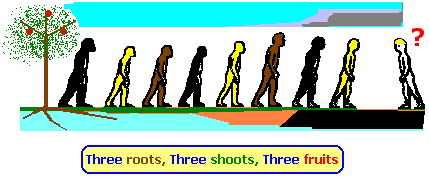
The above picture gives a general idea of a 3-part human lineage (Negroids - Mongoloids - Caucasoids) recurrence without captioning any figure with a particular hominid identity due to the variety of interpretations one might care to offer as truth. I also have illustrated humanity's ascent from green pastures (foliage) into a Savannah (also desert)... into an asphalt jungle.
You also will notice that the underlying blue water-table is decreasing, as well as the overhead blue sky due to pollution. You may also want to view the absence of a tree along-side the future-facing figure as a remark about the loss of trees due to severe over-usage.
The questioning figure at the "end of the line" could be surrounded by grey to indicate not only the darkening environment due to pollution, but also the wish for a "grey"-colored humanity by those who have considered that a blending of all races would achieve a non-prejudiced standard of skin coloring (etc.), and is in a sense, from their point of naive thinking, already occurring from the "outside in"... instead of the "inside out," even though others perceive and prefer that such a change must take place by the opposite view in order for humanity to achieve some semblance of lasting peace.
| Examples: Þ | Science | Christianity | Hinduism |
| 3 Roots: |
|
|
|
| 3 Shoots: |
|
|
|
| 3 Fruits: |
|
|
|
3 typical arguments AGAINST the concept known as RACE:
- Race is a social concept, not a biological one.
- Race, like beauty, is in the eye of the beholder.
- Race is not important and can not be adequately distinguished by any form of test.
3 typical arguments FOR the concept known as RACE:
- Race is a necessary concept that is used extensively in individualized medical treatment.
- Race disproportions found in prisons, poverty, academics, sports, etc., are a representation of disproportinate differences related to race.
- Race distinctions are still distinctions whether they are labeled social, biological, cultural, political, medical, educational, etc...
(The view that "race is a social concept, not a biological one," is itself a social concept based upon a socially constructed biological perspective, and is not a biological concept manifested without social influences concerning race.)
It is said that Racial categories recognized by society are not reflected on the genetic level, whereby the standard labels used to distinguish people by "race" have little or no biological meaning. Yet, neither are such overtly distinct characteristics as hair, eye color, arms, heads, etc., seen on the genetic level, and yet there are specific differences amongst humans clustered in groups when the genes reach full expression in the human form.
...As to what percentage of your genes is reflected in your external appearance, the basis by which we talk about race, the answer seems to be in the range of .01 percent," according to Dr. Harold P. Freeman, the chief executive, president and director of surgery at North General Hospital in Manhattan, who has studied the issue of biology and race. He concludes that "this is a very, very minimal reflection of your genetic makeup."
http://www.webfamilytree.com/do_races_differ.htm
See also:
http://threesology.org/us-versus-them.php
In our attempts to devise a system of distinction amongst animals, plants, and insects, humanity has adopted (and modified) a usage of the taxonomic classification system devised by Linnaeus in 1758:
Animals are identified, in descending order, as belonging to a:
- Kingdom
- Phylum
- Class
- Order
- Family
- Genus
- Species
- Kingdom- Animalia
- Phylum- Chordata because we have a backbone
- Class- Mammalia because we have hair and suckle our young
- Order- Primates because we share with apes, monkeys, and lemurs certain morphological characteristics
- Family- Hominidae because, among a few other criteria, we are separated from the other apes by being bipedal
- Genus- Homo being our generic classification as human
- Species- sapiens, a name meaning, rightly or
wrongly, "wise."
The Linnaean system also recognizes such groupings as superfamilies and sub-families. In the case of the human lineage, the most often recognized superfamily is the Hominoidea (hominoids), which includes all of the living apes. Infant- Will only "label" differences amongst the apples by a method of putting the sweetest apple (apple piece) in their mouth and spitting out sour pieces.
Child- May label all the apple varieties with the singular term of "apple," while some children may include other distinctions such as color, weight, shape/size or tartness/sweetness.
Adult- May label each apple according to more definitive labels based on uses for canning, cooking, baking, frying, storing, cider, sauce, jelly, butter, eating raw, etc...
(I had memorized this in school by reciting a short phrase I made up: In the Kingdom of Phylum was a Class of people called Order in whose Family was a Genus [Genius] called Species.)
This classification system is based largely on the animal's physical characteristics; things that [subjectively] looked alike were placed together, (and those physical characteristics which [subjectively] looked different, were placed apart).
In the Linnaean system, humans would be categorized first as
http://news.nationalgeographic.com/news/2001/12/1204_hominin_id.html
In trying to define the human species in a broad perspective, we use terms such as hominid, humanoid, and Hominidae, because different types of analysis and distinctions require different labels in our attempts at acquiring a larger appreciation of specific traits, qualities, and attributes for enhanced understanding. However, because so many of our labels are derived from broad-ranging myopic (near-sighted) interests, this is like taking the differences known about apples and labeling them collectively as "varieties" instead of on an individualized collective basis called "racial characteristics," and then placing them before an infant, young child, and adult who are asked to arrive at a system of distinction:
In other words, with respect to humans (and apples), we might want to consider adopting the perspective of acknowledging "human variety/diversity" is a euphemistic way of identifying specific characteristics of racial differences amongst life forms given a collective singular label such as human, apple, car, hammer, saw, pencil, paint, money, religion, etc... In a much broader and metaphorical sense, the word "race" need not be anthropocentrically limited to humans.
Present day genetic research is in its infancy, hence, many views that use genetics as a basis of proof should likewise be considered that which is seen through the world view of infancy.

On Nova Episode #2902 entitled "Neanderthals on Trial," an example of Typology development was given using the analogy of pencils. First a group of bunched up pencils was shown as an illustration of what scientists are confronted with when discovering various artifacts, bones, etc... In attempting to find some meaning in the conglomeration of different samples, a system of order (called a typology) is established based upon criteria such as size, color, shape, etc., much like ancient peoples imagined seeing various characters in the stars above because of the patterns they perceived.

In the second image the pencils are arranged in a pattern according to the sizes of small, medium, and large. Different methods of interpretation are used which result in different ways in which the samples can be grouped, all of which may be defended and/or attacked by others who may claim such a pattern does or does not exist for the whole of the group or a particular individual sample.

In the third image we see that the examples of pencils are placed together in a graded fashion suggesting that all examples may be part of an overall single group, though individual investigators may be adamant about particularlizing one or more characteristics of an example that is distinct from all the others and therefore requires a separate classification, as so happens when scientists discover skulls and other bony structures.(Or as in this reference, someone might do when encountering pencils with different advertizements, different types of erasers, different colors, different shapes, different lead hardness... no. 1, no.2, no. 3 etc...) However, what was not expressed in the analogy on the program is that the three groupings were fused into one grouping thereby creating an example of a 3 to 1 ratio. The usage of such a formula appears to be an example of a new cognitive perspective that is emerging in proposals of analyzing in a different way than the typical 3-part divisions so commonly found.
Herb O. Buckland
herbobuckland@hotmail.com